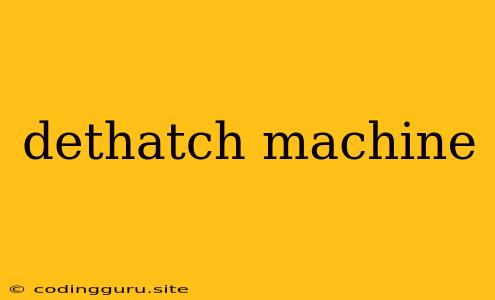What is a Dethatching Machine and When Do You Need One?
A dethatching machine, also known as a scarifier, is a powerful lawn care tool designed to remove thatch from your lawn. Thatch is a layer of dead grass, roots, and other organic matter that accumulates between the soil and the grass blades. While a thin layer of thatch can be beneficial, excessive thatch can suffocate your grass, preventing it from receiving vital nutrients and water. This can lead to a variety of lawn problems, including:
- Poor growth: Thatch blocks nutrients and water from reaching the roots, hindering healthy growth.
- Disease and pests: Thick thatch provides a breeding ground for pests and fungal diseases.
- Uneven growth: Some areas may grow more vigorously than others due to uneven thatch distribution.
- Drought susceptibility: Thatch prevents the soil from retaining moisture, making your lawn more vulnerable to drought.
When is Dethatching Necessary?
If you notice a layer of brown or yellow, matted material on your lawn that's thicker than a half-inch, it's time to consider dethatching. Here are some other signs:
- Poor water drainage: Water pools on the surface after rain.
- Bare patches: Areas of your lawn are thin or have died.
- Difficulty establishing new grass: New seed struggles to germinate and grow.
- Grass growing unevenly: Some areas are taller or lusher than others.
Types of Dethatching Machines
Dethatching machines come in various forms, each with its own pros and cons:
- Manual Dethatching Rakes: These are the most affordable option, perfect for small lawns. However, they require significant physical effort.
- Power Dethatching Rakes: These use a motor to power the blades, making the process faster and easier. They come in both gas-powered and electric models.
- Vertical Mowers (Dethatchers): These machines have vertical blades that cut and remove thatch, leaving a clean and healthy lawn. They are effective for thick thatch and require less effort than rakes.
- Rotary Dethatchers: These have rotating blades that scrape off thatch. They are typically used on larger lawns and can be aggressive.
Tips for Using a Dethatching Machine
- Prepare your lawn: Mow your lawn short before dethatching.
- Choose the right machine: Consider the size of your lawn and the severity of the thatch.
- Overlapping passes: Make sure to overlap your passes by about half the width of the machine.
- Be gentle: Don't push too hard or you could damage your lawn.
- Remove debris: Gather the removed thatch and dispose of it properly.
- Fertilize and water: After dethatching, fertilize and water your lawn to promote healthy growth.
Dethatching vs. Aeration
While both dethatching and aeration improve lawn health, they serve different purposes.
Dethatching: Removes thatch, a layer of dead organic matter on the soil surface.
Aeration: Creates holes in the soil, improving drainage and air circulation.
In many cases, both dethatching and aeration may be beneficial for your lawn.
Maintaining a Healthy Lawn
Dethatching is an important part of maintaining a healthy lawn, but it shouldn't be the only step. Here are some additional tips:
- Regular mowing: Mow your lawn at the proper height and frequency.
- Proper fertilization: Use a balanced fertilizer to provide your lawn with essential nutrients.
- Watering: Water your lawn deeply but infrequently.
- Weed control: Control weeds to prevent competition for resources.
- Pest control: Treat pests and diseases as necessary.
Conclusion
Dethatching your lawn can be a game-changer for its health and appearance. By removing excess thatch, you promote healthy growth, reduce disease and pest risks, and improve water and nutrient absorption.
If you notice signs of excessive thatch, consider using a dethatching machine to rejuvenate your lawn. Remember to choose the right machine, follow the tips for proper use, and continue to practice good lawn care practices.
